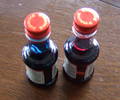Find out how to make your own garishly coloured flowers, and how it relates to the way plants lift water to their leaves.
Ingredients
 | Food Colouring | White flowers - preferably with large fleshy leaves | |
 | A jar or two |
Instructions
Put a little food colouring or ink with 2-3 times as much water in the bottom of a jar. Different food colourings and inks work differently well. For example ink from biros doesn't work very well, and different colours of food colouring produce different results, so don't be afraid to experiment.
Trim the flower stem and put it in the jar for 12 or more hours.
You could try splitting a stem for a few inches up from the middle, and put one half of the stem in one colour in and the other in a different colour.
Result
You should find that the flower changes colour.
Often the colouring isn't evenly spread over the petals.
If you put the two halves of the stem in different colours then the flowers can be multicoloured

Explanation
Land plants have a problem, the water, minerals and other nutrients they need are in the ground but they are needed in their leaves which need to have access to the sun, so they have to be up in the air. This means the plants need a mechanism for transporting water with dissolved nutrients up their stems to the leaves.
They do this using a tissue called xylem, which is made of thousands of tiny tubes, which run from the roots each to a different part of the plant.
Normally the roots sort out what the plant wants and allows that into the xylem. Bit if you cut the stem, you loose the filtering of the roots and the xlem will suck up whatever they are sitting in. This means that you can keep a cut flower hydrated and fairly healthy for a couple of weeks if you put the right nutrients into the water.
It also means that if you put something coloured into the water it will be sucked up all the way into the leaves and the petals.
 |  |

How does the Xylem work?
The xylem is made up of incredibly thin tubes full of water. Each tube runs from the roots to somewhere in a leaf petal or fruit. If water evaporates from the leaf that will concentrate the sugars and salts in the cells there. By the process of osmosis water is moved from the xylem into the cells. Osmosis is the same reason that putting salt on a snail will dry the snail out.
Removing water from the top of the tube reduces the pressure there, this causes water to flow up the tube all the way from the roots.
How does the tube stay full of water?
The tubes are made of a material which is attracted by and attractive to water (hydrophyllic) this means that energy is released by the water wetting the material. Lots of other materials are hydrophyllic, including paper glass and your fingers.
If you put a hydrophyllic object through the surface of a body of water it will attract the water a lift the level of the water around the object. This raised area is called a meniscus.
If you put two hydrophobic objects close together they are both attracting the small amount of water between them, so there is more attraction to lift less water, so the meniscus can rise higher than normal.
If you get the two objects very close together they will lift the water even further.
 |  |  |
| If you put an object which is attracted to water in a bowl of water, the surface rises up either side to form a meniscus | If you move two objects close together then the mensicus in the middle rises up. | If they are very close together then the meniscus rises a long way, as there is less weight of water to lift. |
The tubes in xylem are immensely small, down to 0.01mm across, so the water can rise up between them a huge distance.
| | |
| When I move my fingers very close together the water rises up between them | The closely packed paper fibres have a similar effect, so the water rises up this tissue paper. |
- Previous What can you do with a rolling pin?
- Next Snapping Spaghetti










Comments
Add a comment